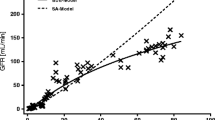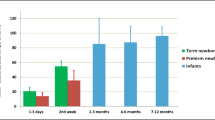Abstract
This study pools published data to describe the increase in glomerular filtration rate (GFR) from very premature neonates to young adults. The data comprises measured GFR (using polyfructose, 51Cr-EDTA, mannitol or iohexol) from eight studies (n = 923) and involved very premature neonates (22 weeks postmenstrual age) to adulthood (31 years). A nonlinear mixed effects approach (NONMEM) was used to examine the influences of size and maturation on renal function. Size was the primary covariate, and GFR was standardized for a body weight of 70 kg using an allometric power model. Postmenstrual age (PMA) was a better descriptor of maturational changes than postnatal age (PNA). A sigmoid hyperbolic model described the nonlinear relationship between GFR maturation and PMA. Assuming an allometric coefficient of 3/4, the fully mature (adult) GFR is predicted to be 121.2 mL/min per 70 kg [95% confidence interval (CI) 117–125]. Half of the adult value is reached at 47.7 post-menstrual weeks (95%CI 45.1–50.5), with a Hill coefficient of 3.40 (95%CI 3.03–3.80). At 1-year postnatal age, the GFR is predicted to be 90% of the adult GFR. Glomerular filtration rate can be predicted with a consistent relationship from early prematurity to adulthood. We propose that this offers a clinically useful definition of renal function in children and young adults that is independent of the predictable changes associated with age and size.




Similar content being viewed by others
Notes
Despite this assumption, one of the authors is a survivor of premature birth in 1946
Abbreviations
- BMI:
-
Body mass index
- BSA:
-
Body surface area
- δ:
-
Asymmetry parameter for the sigmoid hyperbolic model
- Ffat:
-
Fraction of fat mass
- FFM:
-
Fat-free mass
- GFR:
-
Glomerular filtration rate
- Hill:
-
An exponent describing the steepness of the sigmoid hyperbolic model (taken from the equation describing the oxygen dissociation curve originally described by Hill in 1910)
- NFM:
-
Normal fat mass
- NONMEM:
-
Computer software for nonlinear mixed effects modelling
- PMA:
-
Postmenstrual age
- PNA:
-
Postnatal age
- PWR:
-
Power exponent
- TM50 :
-
The maturation half time, i.e. the time to reach 50% of mature function
- VPC:
-
Visual predictive check
References
Chen N, Aleksa K, Woodland C, Rieder M, Koren G (2006) Ontogeny of drug elimination by the human kidney. Pediatr Nephrol 21:160–168
Sonntag J, Prankel B, Waltz S (1996) Serum creatinine concentration, urinary creatinine excretion and creatinine clearance during the first 9 weeks in preterm infants with a birth weight below 1500 g. Eur J Pediatr 155:815–819
Guignard JP, Drukker A (1999) Why do newborn infants have a high plasma creatinine? Pediatrics 103:e49
Rubin MI, Bruck E, Rapoport M, Snively M, McKay H, Baumler A (1949) Maturation of renal function in childhood: clearance studies. J Clin Invest 28:1144–1162
Wilkins BH (1992) Renal function in sick very low birthweight infants: 1. Glomerular filtration rate. Arch Dis Child 67:1140–1145
Swinkels DW, Hendriks JC, Nauta J, de Jong MC (2000) Glomerular filtration rate by single-injection inulin clearance: definition of a workable protocol for children. Ann Clin Biochem 37:60–66
Cole M, Price L, Parry A, Keir MJ, Pearson AD, Boddy AV, Veal GJ (2004) Estimation of glomerular filtration rate in paediatric cancer patients using 51CR-EDTA population pharmacokinetics. Br J Cancer 90:60–64
Bird NJ, Henderson BL, Lui D, Ballinger JR, Peters AM (2003) Indexing glomerular filtration rate to suit children. J Nucl Med 44:1037–1043
Coulthard MG (1985) Maturation of glomerular filtration in preterm and mature babies. Early Hum Dev 11:281–292
Coulthard MG, Hey EN, Ruddock V (1985) Creatinine and urea clearances compared to inulin clearance in preterm and mature babies. Early Hum Dev 11:11–19
Bouvet Y, Bouissou F, Coulais Y, Seronie-Vivien S, Tafani M, Decramer S, Chatelut E (2006) GFR is better estimated by considering both serum cystatin C and creatinine levels. Pediatr Nephrol 21:1299–1306
Grubb A, Nyman U, Bjork J, Lindstrom V, Rippe B, Sterner G, Christensson A (2005) Simple cystatin C-based prediction equations for glomerular filtration rate compared with the modification of diet in renal disease prediction equation for adults and the Schwartz and the Counahan-Barratt prediction equations for children. Clin Chem 51:1420–1431
Beal SL, Sheiner LB, Boeckmann A (1999) NONMEM user’s guide. Division of Pharmacology, University of California, San Francisco
Peters HP (1983) Chapter 4. Physiological correlates of size. In: Beck E, Birks HJB, Conner EF (eds) The Ecological Implications of Body Size. Cambridge University Press, Cambridge, pp 48–53
Janmahasatian S, Duffull SB, Ash S, Ward LC, Byrne NM, Green B (2005) Quantification of lean bodyweight. Clin Pharmacokinet 44:1051–1065
Duffull SB, Dooley MJ, Green B, Poole SG, Kirkpatrick CM (2004) A standard weight descriptor for dose adjustment in the obese patient. Clin Pharmacokinet 43:1167–1178
Boyd E (1935) The growth of the surface area of the human body. University of Minnesota Press, Minneapolis
Sharkey I, Boddy AV, Wallace H, Mycroft J, Hollis R, Picton S (2001) Body surface area estimation in children using weight alone: application in paediatric oncology. Br J Cancer 85:23–28
Hill AV (1910) The possible effects of the aggregation of the molecules of haemoglobin on its dissociation curves. J Physiol 14:4–7
Anderson BJ, Holford NH (2008) Mechanism-based concepts of size and maturity in pharmacokinetics. Annu Rev Pharmacol Toxicol 48:303–332
Anderson BJ, Allegaert K, Van den Anker JN, Cossey V, Holford NH (2007) Vancomycin pharmacokinetics in preterm neonates and the prediction of adult clearance. Br J Clin Pharmacol 63:75–84
Richards FJ (1959) A flexible growth function for empirical use. J Exp Bot 10:290–300
Wahlby U, Jonsson EN, Karlsson MO (2001) Assessment of actual significance levels for covariate effects in NONMEM. J Pharmacokinet Pharmacodyn 28:231–252
Wahlby U, Bouw MR, Jonsson EN, Karlsson MO (2002) Assessment of type I error rates for the statistical sub-model in NONMEM. J Pharmacokinet Pharmacodyn 29:251–269
Parke J, Holford NH, Charles BG (1999) A procedure for generating bootstrap samples for the validation of nonlinear mixed-effects population models. Comput Methods Programs Biomed 59:19–29
Al-Dahhan J, Haycock GB, Chantler C, Stimmler L (1983) Sodium homeostasis in term and preterm neonates. I. Renal aspects. Arch Dis Child 58:335–342
James A, Koren G, Milliken J, Soldin S, Prober C (1987) Vancomycin pharmacokinetics and dose recommendations for preterm infants. Antimicrob Agents Chemother 31:52–54
van der Heijden AJ, Grose WF, Ambagtsheer JJ, Provoost AP, Wolff ED, Sauer PJ (1988) Glomerular filtration rate in the preterm infant: the relation to gestational and postnatal age. Eur J Pediatr 148:24–28
Aperia A, Broberger O, Elinder G, Herin P, Zetterstrom R (1981) Postnatal development of renal function in pre-term and full-term infants. Acta Paediatr Scand 70:183–187
Cuzzolin L, Fanos V, Pinna B, di Marzio M, Perin M, Tramontozzi P, Tonetto P, Cataldi L (2006) Postnatal renal function in preterm newborns: a role of diseases, drugs and therapeutic interventions. Pediatr Nephrol 21:931–938
Holford NHG (1996) A size standard for pharmacokinetics. Clin Pharmacokinet 30:329–332
West GB, Brown JH (2005) The origin of allometric scaling laws in biology from genomes to ecosystems: towards a quantitative unifying theory of biological structure and organization. J Exp Biol 208:1575–1592
van den Anker JN, de Groot R, Broerse HM, Sauer PJ, van der Heijden BJ, Hop WC, Lindemans J (1995) Assessment of glomerular filtration rate in preterm infants by serum creatinine: comparison with inulin clearance. Pediatrics 96:1156–1158
Coulthard MG, Hey EN (1984) Weight as the best standard for glomerular filtration in the newborn. Arch Dis Child 59:373–375
Dewey FE, Rosenthal D, Murphy DJ Jr, Froelicher VF, Ashley EA (2008) Does size matter? Clinical applications of scaling cardiac size and function for body size. Circulation 117:2279–2287
Hayton WL (2000) Maturation and growth of renal function: dosing renally cleared drugs in children. AAPS PharmSci 2:E3
Calder WA, Braun EJ (1983) Scaling of osmotic regulation in mammals and birds. Am J Physiol 244:R601–R606
Brody S, Proctor RC, Ashworth US (1934) Basal metabolism, endogenous nitrogen, creatinine, and sulphur excretions as functions of body weight. Univ Mo Agric Exp Sta Res Bull 220:1–40
Singer MA, Morton AR (2000) Mouse to elephant: biological scaling and Kt/V. Am J Kidney Dis 35:306–309
Singer MA (2001) Of mice and men and elephants: metabolic rate sets glomerular filtration rate. Am J Kidney Dis 37:164–178
Edwards NA (1975) Scaling of renal functions in mammals. Comp Biochem Physiol A 52:63–66
Savage VM, Gillooly JF, Woodruff WH, West GB, Allen AP, Enquist BJ, Brown JH (2004) The predominance of quarter-power scaling in biology. Funct Ecol 18:257–282
Poole SG, Dooley MJ, Rischin D (2002) A comparison of bedside renal function estimates and measured glomerular filtration rate (Tc99mDTPA clearance) in cancer patients. Ann Oncol 13:949–955
Dooley MJ, Poole SG (2000) Poor correlation between body surface area and glomerular filtration rate. Cancer Chemother Pharmacol 46:523–526
Peters AM, Gordon I, Sixt R (1994) Normalization of glomerular filtration rate in children: body surface area, body weight or extracellular fluid volume? J Nucl Med 35:438–444
Leger F, Bouissou F, Coulais Y, Tafani M, Chatelut E (2002) Estimation of glomerular filtration rate in children. Pediatr Nephrol 17:903–907
Stevens LA, Coresh J, Greene T, Levey AS (2006) Assessing kidney function–measured and estimated glomerular filtration rate. N Engl J Med 354:2473–2483
Engle WA (2004) Age terminology during the perinatal period. Pediatrics 114:1362–1364
Tod M, Lokiec F, Bidault R, De Bony F, Petitjean O, Aujard Y (2001) Pharmacokinetics of oral acyclovir in neonates and in infants: a population analysis. Antimicrob Agents Chemother 45:150–157
Arant BS Jr (1978) Developmental patterns of renal functional maturation compared in the human neonate. J Pediatr 92:705–712
Schwartz JB (2003) The influence of sex on pharmacokinetics. Clin Pharmacokinet 42:107–121
Matthews I, Kirkpatrick C, Holford N (2004) Quantitative justification for target concentration intervention–parameter variability and predictive performance using population pharmacokinetic models for aminoglycosides. Br J Clin Pharmacol 58:8–19
Martini S, Prevot A, Mosig D, Werner D, van Melle G, Guignard JP (2003) Glomerular filtration rate: measure creatinine and height rather than cystatin C! Acta Paediatr 92:1052–1057
Heilbron DC, Holliday MA, al-Dahwi A, Kogan BA (1991) Expressing glomerular filtration rate in children. Pediatr Nephrol 5:5–11
Han PY, Duffull SB, Kirkpatrick CM, Green B (2007) Dosing in obesity: a simple solution to a big problem. Clin Pharmacol Ther 82:505–508
Du Bois D, Du Bois EF (1916) Clinical calorimetry: tenth paper. A formula to estimate the approximate surface area if height and weight be known. Arch Intern Med 17:863–871
Financial Support:
Support was provided solely from institutional and/or departmental sources.
Ethical approval
Ethical approval was not required.
Author information
Authors and Affiliations
Corresponding author
Rights and permissions
About this article
Cite this article
Rhodin, M.M., Anderson, B.J., Peters, A.M. et al. Human renal function maturation: a quantitative description using weight and postmenstrual age. Pediatr Nephrol 24, 67–76 (2009). https://doi.org/10.1007/s00467-008-0997-5
Received:
Revised:
Accepted:
Published:
Issue Date:
DOI: https://doi.org/10.1007/s00467-008-0997-5




